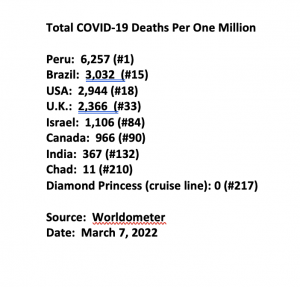Sweden has seen a drop in cases and hospitalizations since it abolished its remaining pandemic restrictions.
Scientists criticized the move on February 9 as premature, but the policy has been a success, say Swedish government officials.
“There are no indications that the opening increased spread, so we assess that it was relevant and correct,” Karin Tegmark Wisell, director general of the Public Health Agency of Sweden, said at a press conference on March 3.
Famously, Sweden was one of few countries that chose not to lock down its citizens and economy in 2020.
‘Persuasion, Not Coercion’
Sweden took a different approach to the pandemic than other countries, says Twila Brase, president of the Citizens’ Council for Health Freedom (CCHF).
“Not locking down was a controversial position at the time, but Swedish health officials held to it,” said Brase. “Anders Tegnell, [Sweden’s] chief epidemiologist, was instrumental in that decision. Officials used persuasion, not coercion.”
Sweden has one of the lowest COVID-19 mortality rates in Europe, at 1,614 deaths per million people, compared to lockdown-heavy Britain’s 2,335 per million, for example. Sweden also took on a smaller debt burden than lockdown countries such as Britain.
Sweden’s approach protected its economy, says the Committee to Unleash Prosperity, a free-market advocacy group.
“This year it’s projected to be 5 percent larger than before the pandemic, versus a two percent gain for Germany and one percent for Britain,” stated the free-market organization’s newsletter, on February 15. “The level of extra debt Sweden has had to take on is a fraction of that in lockdown countries.”

A Hands-Off Approach
Sweden’s Public Health Agency in 2020 touted its focus on clear, consistent messaging and personal responsibilityinstead of lockdowns.
Tegnell defended his nuanced approach to the pandemic, saying in a September 2021 interview that Sweden’s legal system forced them to “focus on areas where we really can see that there is a high level of threat.”
Sweden’s COVID-19 deaths exceeded neighboring countries in the early stages of the pandemic because they were not more vigorous in protecting nursing home residents, says Joel S. Hirschhorn, founder of the Pandemic Blunder Newsletter.
“Like the U.S. and some other nations, nearly half the COVID deaths were in nursing homes and nearly 90 percent of deaths were in people 70 years or older, again similar to the U.S. and other nations,” said Hirschhorn.
“It is also important to note that generally, the Swedish population is healthier than Americans, with fewer chronic comorbidities, especially obesity,” said Hirschhorn.
Treatment Worked
The verdict is in on other approaches taken to protect people from the virus, and not just from Sweden, says Brase.
“Various Indian and South African countries, as well as South American countries, likely did better than the U.S. because they used early treatment,” said Brase. “Many of them were already on hydroxychloroquine to prevent malaria,” she said. “And in Uttar Pradesh, a state of India with more than 240 million people, the government distributed early treatment kits including ivermectin—and the cases and deaths plummeted.”
Other public health measures have not worked as expected, says Brase.
“Scrubbing surfaces was mostly stopped after it was recognized that the virus spread through the air (aerosolization) and, at some point in 2021, it was acknowledged that the plexiglass barriers in schools did virtually nothing,” said Brase.
Vaccines Less Effective
Another measure that failed to live up to its promise has been vaccines, says Brase.
“The vaccines didn’t work to stop COVID, stop transmission, [or] decrease viral load,” said Brase. “They provided no sterilizing immunity, so they really are not vaccines. In some countries, the vaccinated are suffering higher rates of hospitalization, such as in Scotland and Israel.
“The injections may have decreased severity of disease for the especially vulnerable, but they also caused death and damage to some of the vaccinated, and we don’t yet know the full impact of the genetic injections because there was insufficient study before injections,” said Brase.
“In addition, it appears the vaccines given in the midst of a pandemic may have led to the long line of variants we experienced,” she said.
There is one lesson from all the approaches to the pandemic, says Brase.
“A virus is a virus, and it’s impossible to control a virus,” said Brase.
Harry Painter (harry@harrypainter.com, @TheHarryPainter) writes from Tulsa, Oklahoma.






















[…] Sweden’s Approach to the Virus Wins Accolades […]